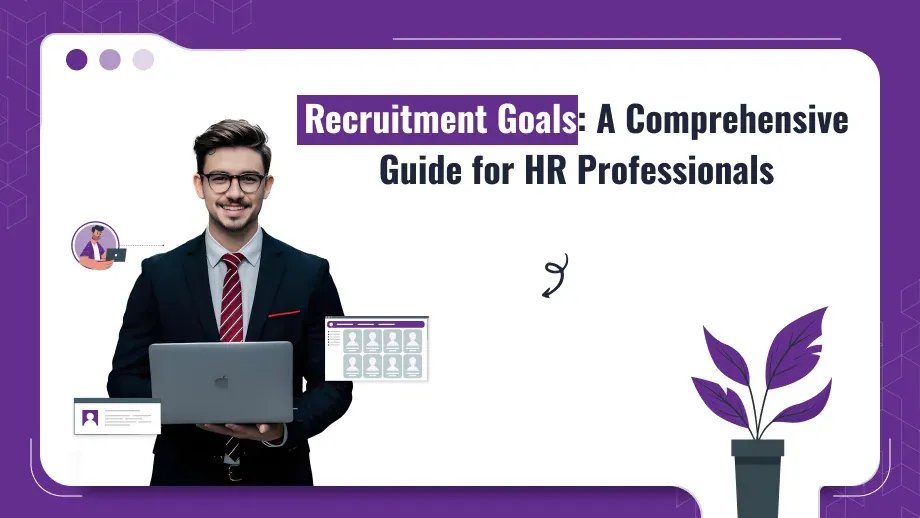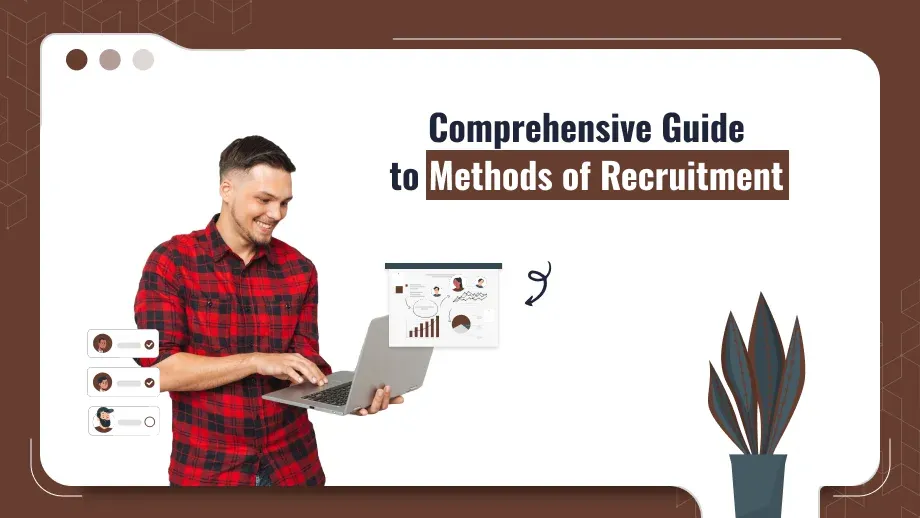
The new recent trends in recruitment in contemporary times enable companies to locate, evaluate, and recruit the most talented employees from within an organization quickly. The biggest shift companies must navigate when it comes to job markets is the dynamic change required to achieve great talent. With higher technology, a growing trend toward remote work, and more demands for diversity, hiring for companies takes into account efficiency and inclusiveness. The article is concerned with what the recent trends in recruitment are, how they are used in real life in hiring and major challenges on the horizon for the future of recruitment.
Recent Trends in Recruitment
Remote and Hybrid Recruitment Models
Recent trends in recruitment are dominated by a shift to more remote and hybrid models. The COVID-19 pandemic has super-charged the spread of remote work to such an extent that it is now no longer the exception but the rule. Companies today can recruit globally, tapping the best talent anywhere in the world without having to relocate talent on-site.
- Applications in India: Recent trends of recruitment in India show that the entire tech industry has absorbed remote recruitment and now develops human resources from different parts of the state. Organizations also understand the advantages of hybrid models, whereby teams work partly from home and partly in the office.
- Future Potential: Remote recruitment will be here to stay. Since technology is sure to advance smooth virtual communication, companies will continue their optimal productivity and engage a bigger, more diversified pool of candidates to fulfill the demands of a globalized job market.
Artificial Intelligence and Automation in Recruitment
Among recent trends in recruitment process, the emerging aspect is the incorporation of AI and trends in hiring, which is, at present, changing how various companies across different industries are hiring. Consistent with this trend, data-driven tools, like applicant tracking systems, scan resumes very quickly, filter a candidate through his needed skills, and help streamline candidate selection.
- Practical Example: AI is now used by companies to automate the first stages, resume screening, and interview scheduling. Businesses save significantly on time while recent trends in recruitment using technology recruitment solutions and are also less biased in the hiring process, thus making it more efficient and fair.
- Future Trends: AI will likely extend its reach to more recruitment functions. From conducting initial video interviews to analyzing candidates’ responses and helping to weigh in culture, AI will be an integral part of all future trends in recruitment.
Data-driven recruiting and Predictive Analytics
Data-driven recruiting is one of the fundamental recent trends in recruitment, whereby companies will make strategic decisions based on information related to better choices. Generally, tracking the key recruitment metrics, such as cost-per-hire and quality-of-hire, allows the HR teams to recruit more efficiently and effectively use resources.
- Impact on Hiring Strategies: Predictive analytics is used to predict the future hiring requirements for an organization. It even provides insights on attrition patterns and alerts on potential talent gaps in advance. Therefore, companies get a chance to assess the recruitment trends and then modify strategies that would align well with future needs and reduce turnover rates.
- Future of Data-Driven Recruitment: It will thus become data-driven, as increasing data on metrics that recent trends in recruitment are likely to grow exponentially. Predictive analytics will, therefore be able to influence more proactive recruitment that identifies talent needs before they arise.
Diversity and Inclusion as a Recruitment Priority
Diversity and inclusion have morphed from a corporate ideal to the sole means of recruiting. Organizations understand that a distinct composition of individuals will create innovation, improve decisions, and resonate stronger with local markets globally.
- Recent Developments: More companies are increasingly adopting diversity recruiting plans, including using diverse job boards, changing words in job postings, and having blind resume reviews that eliminate some biases.
- Future Trends in Diversity: In the future, D&I practices will still be a best practice in hiring, and companies will continue to develop their practices with more data-driven efforts and outreach programs that will result in inclusivity within the workplace.
Recruitment Marketing and Employer Branding
The other recent trends in recruitment is that it is all about employer branding. Through marketing, companies employ an effort to attract the best talent through the cultures, values, and experiences of the employees via social media and career sites.
- Real-World Example: Organizations share different kinds of content related to employee experience, company culture, and development opportunities on LinkedIn, Instagram, and Glassdoor. Strong employer branding also gives companies an edge in this competitive marketplace.
- Future Perspective: Employer branding would be that much more important as recruitment marketing would gain much more popularity. Candidates now seek correspondence with the values and culture of a company, so well-crafted brand images are needed to meet those expectations.
Enhanced Candidate Experience
One of the hottest recent trends in recruitment that has emerged is the candidate experience from the first touch point to the final offer, firms ensure a smooth and engaging enough experience to hold a candidate’s interest till the very end.
- Why It Matters: A great experience enables a higher rate of acceptance for offers and improves the company’s reputation in return, which equates to a bigger talent pool in the long run.
- Application of Technology: This will ensure no nervousness of the candidate and ensure that the company is communicating instantaneously. In this manner, companies can guarantee a smooth, transparent experience from application all through onboarding using such tools.
Social Recruiting and Employee Referrals
Social recruiting and referrals are among the best channels recent trends in recruitment, tapping into the networks of employees and online platforms for quality candidates. Social media enables companies to access both active and passive job seekers through less formal ways.
- Application Example: Organizations encourage employees to refer qualified candidates and offer incentives, hence making referral programs one of the most effective hiring strategies.
- Future Potential: Social recruiting will be much greater with even more companies using social platforms like LinkedIn, Twitter, and Facebook to develop relationships and expand the pipeline of potential candidates.
Upskilling and Reskilling
This competency shift is when firms change industries, thereby changing the upskilling and reskilling requirements of the existing employees in a company. It also focuses on continuous training that allows an employee to adapt or change into new roles or requirements.
- Internal Mobility: internal recruitment and keeps high-potential employees within the organization while reducing turnover and hiring costs.
- Future Perspective: Upskilling will be integral to organizations as companies find more reasons not to seek to go outside talent acquisition to bridge gaps but instead upskill the workforce for sustainability.
Integration of Advanced Recruitment Technology
In recent trends in recruitment, advanced tools such as a talent management system and the HRMS platform form an integral part of getting involved with managing the recruitment metrics and tracking the progress of candidates about optimizing the workflow of hiring.
- Technology Impact: From streamlining candidate management to actionable data insights, advanced recruitment tools are becoming the facilitators for a smoother and more streamlined process for HR in terms of recent trends in recruitment.
- Future Trends: With evolving technology, upcoming years will see companies leveraging tools that can provide detailed reporting capabilities along with tracking details related to candidates, which will effectively make the recruitment process more transparent and efficient.
Make sure your hiring is up to date!
Embrace the recent trends in recruitment to attract top talent and streamline your hiring process.
Major Challenges in the Future of Recruitment
The recruitment landscape is always shifting, and with that, come gigantic challenges. Organizations now begin using novel tools, strategies, and hiring practices to fill positions within their organization facing many obstacles on their way to hiring goals. Well, here’s a look at some of the most pressing challenges the recent trends in recruitment lie with, and how companies can seize opportunities to tackle them.
Adapting to Rapid Technological Advancements
Occasionally, technology has been evolving so rapidly that it cannot be measured, especially concerning recent trends in recruitment. It’s now being dominated by automation, AI, and data analytics. Keeping up with these developments is tough for any firm, particularly the smaller ones, or when resources are scarce.
- Why It’s a Challenge: New technologies also come along with steeper learning curves, meaning a need for more time and training investment. Also, the efficiency provider tools may be ATS or AI-technology-powered platforms but costly and hence require an ongoing renewal cycle to stay effective.
- Potential Solutions: It is a reality that a lot of organizations have to maintain with the changing technological advancements. A lot of scalable systems must be invested in to keep up with the changes. Investing in a Talent Management System or an HRMS platform with inbuilt flexibility would reduce the organization’s constant need for upgrading.
- Holding regular training sessions for their HR teams can ensure that individuals remain prepared to administer the new tools to the fullest. Also, having a technology recruitment partner on their side can aid them in selecting the best solutions.
Meeting Diversity and Inclusion Goals Amidst High Competition
Such diverse talents continue to be more heavily emphasized within recent trends in recruitment, but bringing those into actual performance seems much more challenging because of excessive demand for such diverse talent in the specialized field, where a company faces immense competition for attracting and holding such different candidates.
- Why It’s a Challenge: Specialized talent pools – in tech and engineering or any scarce skill – tend to have fewer representatives from underrepresented groups. Organizations need to balance the demands of D&I with other high-value requirements, such as an appropriate skill level and cultural fit, which tends to reduce the candidate pool.
- Potential Solutions: organizations should have the ability to expand their sources of sourcing by including niche job boards, diversity-focused recruitment events, and partnerships with organizations that support underrepresented groups.
- Other potential solutions are building diversity recent trends in recruitment, which include having inclusive language in a company’s job descriptions and unbiased tools in making assessments. Employer branding would also increase the appeal of the company when being transparent about D&I goals.
Ensuring Compliance with Data Privacy and Protection Laws
The increasing dependence of recent trends in recruitment on data collection and processing with such huge volumes of data calls for greater importance of data privacy compliance. New data protection laws, for example, GDPR (General Data Protection Regulation) and CCPA (California Consumer Privacy Act), thus brought stringent regulations upon candidate data being placed, accessed, and used by recruiters.
- Why It’s a Challenge: Violation of data privacy laws will attract significant penalties, apart from damaging the goodwill of the company. More so, since data is widely scattered, achieving uniformity in privacy control is indeed cumbersome.
- Potential Solutions: Organizations should instead invest in secure data management, particularly in platforms that support rich features for the protection of stored data.
- In most ATS systems and HR recruitment process software, for example, data is encrypted at the time of storage, and compliance features ensure the protection of sensitive information. Sometimes, errors due to transference are caused by accidentally not following best practices in data privacy laws; hence, multiple trainings of the recruitment team assure little breach risks.
Managing Candidate Expectations for Speed and Transparency
The applicants today have a lot of expectations from the recent trends in recruitment. They want an easy and quick experience in hiring while receiving the utmost level of transparency as provided at all stages of the process. Failure to attend to these expectations will attract candidate drop-off and finally impact very badly on the organization’s reputation.
- Why It’s a Challenge: A slow or unclear hiring process may lose interest in candidates or attract offers from competitors. But only a smoothly organized process that will keep on sending regular updates at the right time makes the whole process completely transparent and resource-intensive.
- Potential Solutions: To create a candidate-centric process, companies should use tools like ATS systems to automate and streamline communications. Sending regular updates, offering clear timelines, and providing feedback after interviews can enhance the candidate experience. Virtual chatbots and automated emails can answer frequently asked questions, reducing candidate uncertainty and keeping them engaged throughout the hiring journey.
Addressing Skill Gaps with Limited Talent Availability
Multinational companies are now facing a growing skill gap as industries evolve, new technologies are introduced, and recruitment efforts fail to yield the desired profile. It is increasingly challenging to find the ideal candidate who comes with a specific technical or digital skill for the job, especially for those with up-to-date knowledge related to AI, cybersecurity, and data science.
- Why It’s a Challenge: Skills gaps mean longer recruiting periods and additional recruitment expenses added on. Additionally, firms have had to decide whether to upskill existing workers or pay them better to attract outside talent who possess these required skills.
- Potential Solutions: To bridge skill gaps, companies can focus on upskilling and reskilling their current workforce. Offering training programs and development opportunities enables internal mobility and reduces reliance on external hires. For critical roles, working with educational institutions and offering internships or apprenticeships can also create a talent pipeline of skilled workers.
Leveraging Recruitment Data While Ensuring Human Interaction
Data-driven recruiting is one of the recent trends in recruitment witnessed in the recruitment world recently. Now that organizations can make better hiring decisions, based on data analysis, it seems that data-driven recruiting should slowly gain a footing in most organizations. Still, with all these efficiencies that have been brought about, there is a feeling that data favors its dependence on being over-automated, thereby losing the human touch to the recruitment process.
- Why It’s a Challenge: It leads to lesser human-to-human interaction, which forms an integral part of assessing the soft skills and cultural fit of a candidate. A process coming across as impersonal to candidates is alienating.
- Potential Solutions: good balance comes through, in this case, when companies use data as a supportive tool and not a means of replacing human judgment.
- The idea of taking on ATS and recruitment technology tools can speed up initial screenings and in-depth interviews, but personal interactions must be considered when picking candidates. Human contact remains an essential aspect when assessing the qualities that data cannot capture, such as adaptability and emotional intelligence.
Adapting Recruitment Processes to Evolving Workforce Preferences
Today’s workforce has different expectations from previous generations, with many employees valuing work-life balance, remote work options, and flexible schedules. Adapting to these evolving preferences is essential for attracting top talent but can be challenging for companies with traditional recent trends in recruitment and employment practices.
- Why It’s a Challenge: Accommodation takes on the form of altered recruitment processes, benefits packages, and structure of the job. Organizations that do not adapt may lose talent wanting flexibility and a positive work environment.
- Potential Solutions: There should be provisions for flexible working, encouragement of remote working options, and a strong employer brand with work-life balance. Such traits might attract the right talent to the job post. They can also be advertised in job postings or during interviews.
Conclusion
As recent trends in recruitment continue to evolve, companies that adapt well will be placed among the best. From diversity recruiting and sustainability to AI and gig work, these are trends that have further exposed doors for engaging and retaining top talent at organizations. Only future challenges can make organizations build resilient hiring practices according to long-term goals toward a workforce prepared for the demands of tomorrow.





